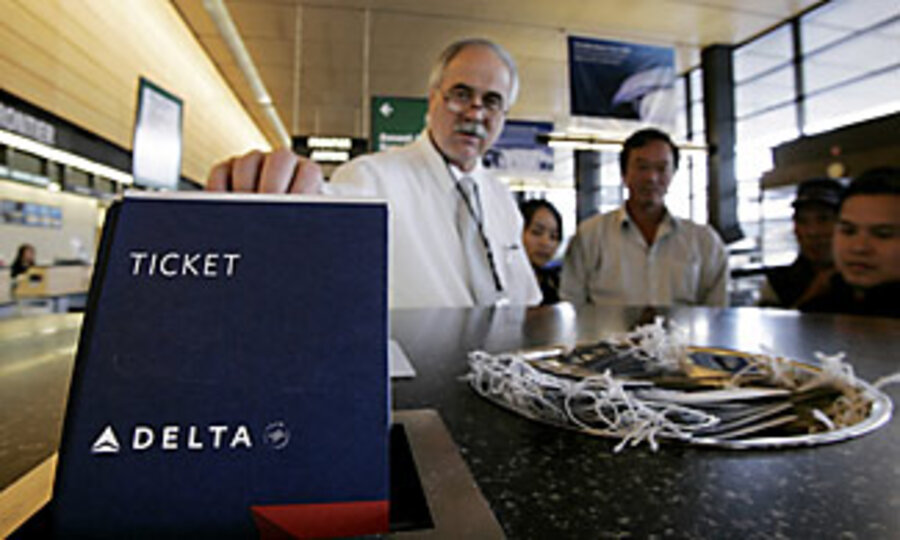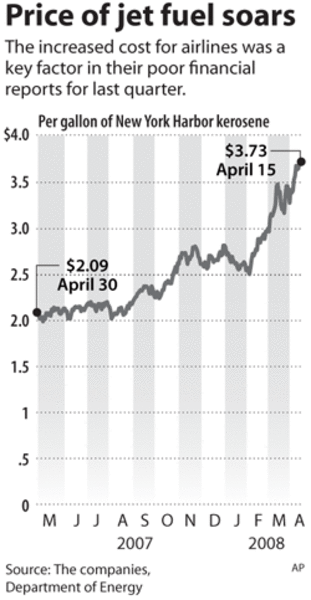Airline woes to boost ticket prices
Loading...
| New York
Most of America's major airlines are again losing hundreds of millions of dollars.
This time, the causes are escalating jet-fuel prices and intense competition.
This latest round of red ink started to flow just as the airlines were finally getting back in the black after losing record amounts of money in the post-9/11 era.
For passengers, the latest losses mean higher fares, more crowded planes, longer delays, and steadily deteriorating service. But beyond that daily hassle factor, there is a much higher price to the economy, analysts say.
The aviation industry is a backbone of the US economy. It was once the gold standard that countries around the world looked to for cutting-edge innovations. Now it lags behind much of the rest of the world with an old, inefficient fleet and an air-traffic control system based on 1950s technology. And that takes a toll on the bottom line of other US businesses.
Few in the airline or the political worlds are willing to tackle a key question, aviation analysts say: What does the government have to do to ensure a vibrant, competitive domestic and international aviation industry?
"There is a policy issue here that no one in government has been willing to step up to since deregulation: That's the need for a national aviation policy," says aviation analyst Robert Mann, president of R.W. Mann. & Co. in Port Washington, N.Y. "It's going to be as popular as a root canal, but on the other hand if you don't, it will just get worse."
This week US Airways, Delta, and United joined three other major carriers in reporting hundreds of millions of dollars of losses in the first quarter of the year because of jet-fuel prices. The only big airline to post a profit is the low-cost giant Southwest Airlines.
In most industries, when the cost of providing a service goes up, so, too, does the price of the service. And airline fares have been inching up. They increased an average of 4 percent during the fourth quarter of last year, according to figures released this week by the Department of Transportation's Bureau of Transportation Statistics. But that still leaves airfares lower than they were in 2000. In fact, fourth-quarter fares in 2007 were still 2.7 percent below the high set back in 2000.
The reason that airlines don't just hike prices more, analysts say, is that they're afraid of losing passengers, especially with the economic slowdown. The competition is intense for Americans' flying dollars.
"The airlines are so used to moving in lock step with each other that there may just be a reluctance to be the first [to hike prices significantly,]" says Clint Oster, an aviation economist at Indiana University at Bloomington. "And they're all a little bit jumpy about competing with Southwest, even though [that carrier is] also feeling the same kinds of cost pressures."
What this means is that the big network airlines, which went through a series of difficult restructurings and bankruptcies in the past seven years so they could compete with the Southwests of the world, still aren't able to charge enough money to cover their basic costs – especially with the recent spike in fuel prices. This is the case even though planes are flying fuller than ever before. (Remember the last time there was an empty middle seat on your flight?)
"They're filling the planes, but not at a price they can make money at, so they lose money," says Richard Golaszewski, an aviation analyst with GRA Inc. in Jenkintown, Pa. "That's a signal that it's time to reduce capacity ... so that with the same average load [of passengers], you can make money."
With planes flying so full, it may not make sense to the average, cramped passenger that the system has too much capacity. But analysts say it's not a physical capacity problem, but an economic one. If airlines cut back on the number and frequency of flights, which several have indicated this week that they will, it will allow them to charge more for the remaining seats. What this means is even more bad news for passengers: fewer choices and higher prices.






